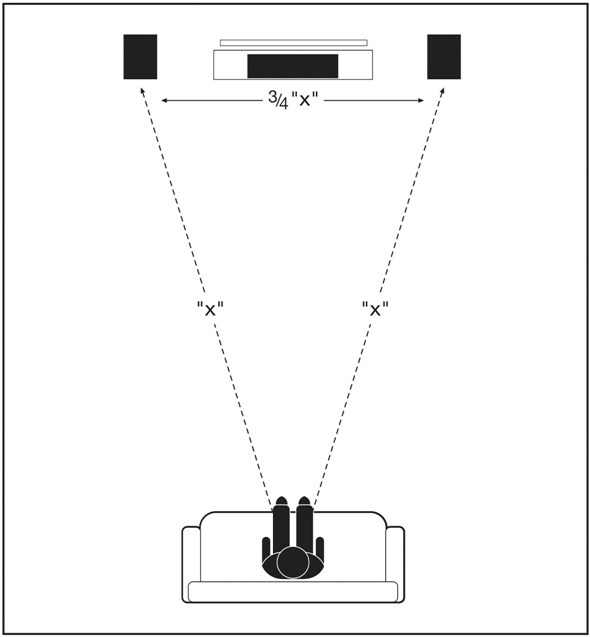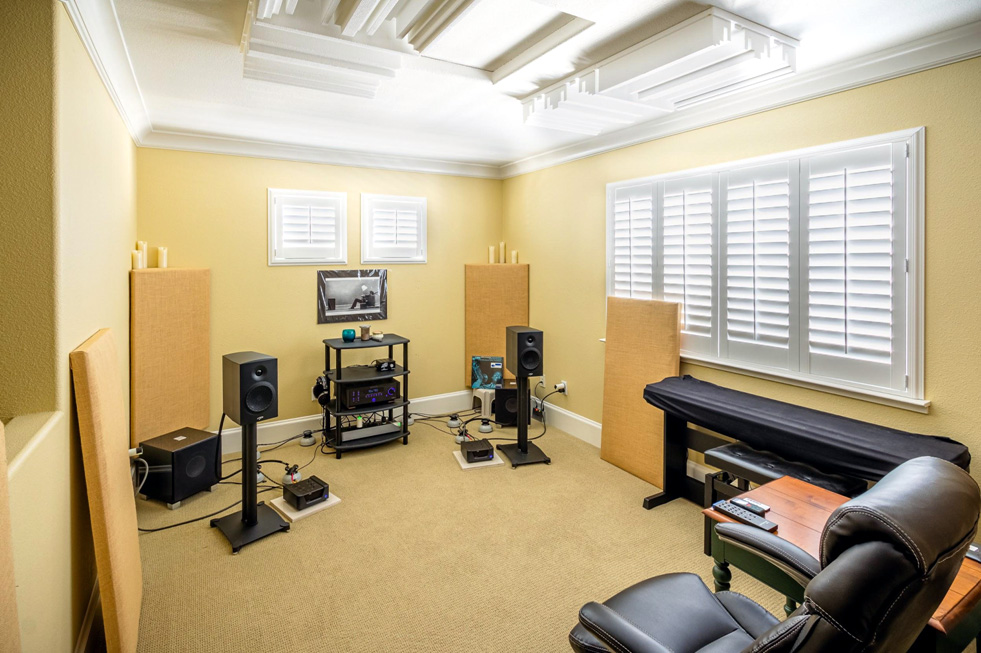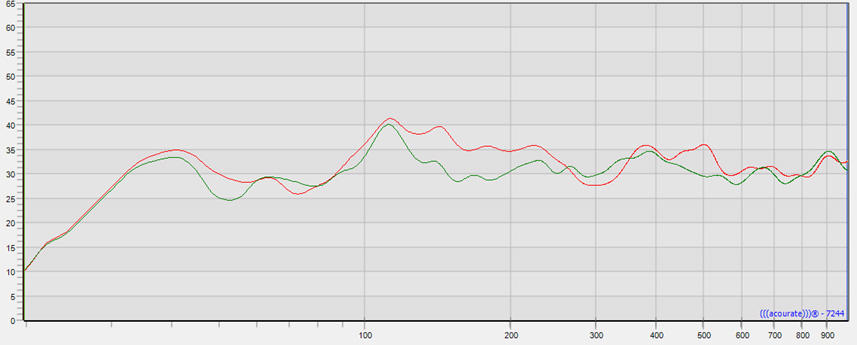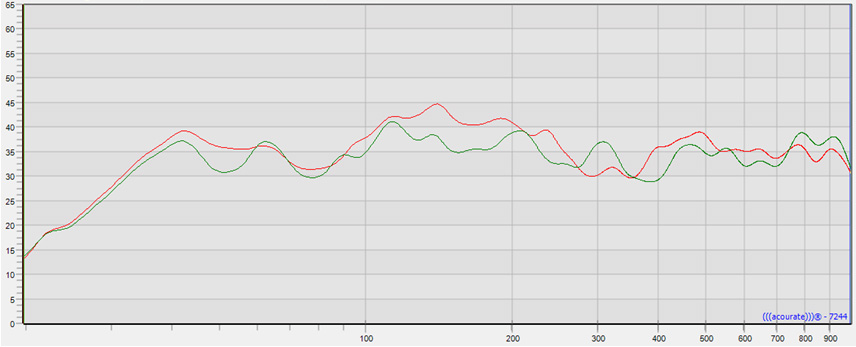Premier 200B Setup

OPTIMAL IMAGING Measure the distance from your main listening area to the front speakers (“X”). For best imaging, place speakers from three-quarters of that distance up to that same distance from each other (3/4 of “X” to “X”), as shown. To further optimize imaging, toe speakers slightly inward so they point toward the listening position with their axes crossing just behind it, as shown.
Getting the 200B optimally placed in my 15.5 x 10.1 ft listening room required a little more trial and error than usual. This is not a big room, so to make the most of the space I usually position bookshelf speakers about 6.5 ft apart with the tweeters about 7.5 ft or so from my ears. Toe-in depends on what’s required to achieve a pleasing tonal balance, solid center-fill, and a satisfyingly large soundstage with no gaps. The 200B sounded too thin and lacked presence with them over 6 ft apart. This result is consistent with Paradigm’s recommendation in the manual; the distance from tweeter to tweeter should be about 75% of that from tweeter to ear.
It’s amazing what can happen when one follows the directions. Tone and presence were much better after I moved them closer together, so all that was left was setting toe-in. Firing the speakers straight down the room was an incoherent mess, so I started by crossing them just a bit behind my head (I could only see a sliver of the inside edge of each cabinet); however, this produced a “head-in-a-vice” soundstage—move your head a half an inch in either direction and the stage lost focus. Adjusting toe-in out a bit, enabling me to see a wider inside edge, brought about the right balance. In my room, the front of the speakers is 4.5 ft from the rear wall, giving them plenty of space to breathe and for soundstage depth to develop.
Bass extension is satisfying but fails to reach the depths of other 6.5-inch 2-ways I’ve had in this space, which was a bit surprising given the size of the 200B’s cabinets. With room-gain, there’s usable output down to almost 30 Hz, but they fail to pressurize the room without a little help from the REL T7i 8-inch subs in the corners behind them. This is actually not a dealbreaker since many customers will use the 200B with one or more subwoofers. I’d much rather have high-quality bass that rolls off a bit early than bass that’s plentiful but less well behaved.
I’ve already touched on the mids and highs, but in addition to its evenness of tone, the 200B has wonderful presence and resolution in the mids. Early in the break-in process, vocals sounded a little congested, but after several dozen hours of playback, they opened up nicely. Highs are on the forward side of neutral, balanced nicely by amplification and sources that are neutral or neutral-to-warm.
As I mentioned in my previous mini-monitor review, I don’t attempt to take anechoic, quasi-anechoic, or close-miked measurements in an attempt to verify manufacturers’ claims about speaker performance. But I do measure a sweep from 20 Hz to 1 kHz from my listening position to get a sense of the tonal balance of the combined loudspeaker and room system.
As you can see, with room gain, we’re down about 5 dB at 30 Hz. The rest of the bumps and ridges in response are fairly consistent with what I always see in this room. No room is perfect, but our brains are remarkably adept at accommodating these aberrations. For comparison, here’s a measurement of the previous monitors that I reviewed. Note that there are more similarities than differences. The room has that great of an influence over what we actually hear.
Description of 200B Playing Different Types of Music
- Hat and Beard performed by Eric Dolphy from Out to Lunch
This is a nearly atonal, avant-garde piece from 1964. The 200B throws the percussion and mad soloists to the far edges of the soundstage while bass and vibes float palpably between the speakers. The sounds are sharp and direct, having a tactile quality—as if the speaker drivers are mechanically connected to my ears. I feel the music as much as I hear it. Although many sounds are panned far to the left and right, they seem to be coming from a point behind the speakers and playing through them rather than emanating from the drivers. The vibes are almost visible; only image height betrays absolute realism. The snare drum has a convincing body and weight. - How Can It Be performed by Bria Skonberg from Bria
The soundstage has plenty of height in this recording…significantly more than the Eric Dolphy piece. While the presentation is lively, there’s not a hint of sibilance in Bria’s vocals. There’s plenty of air around vocals and instruments. The acoustics have a live feel, and the 200B communicates a sincere sense of joy from this performance. I can almost see Bria smiling as she sings. - A Lover in Berlin performed by Kari Bremnes from Norwegian Wood
Kari’s voice on this album has a reedy quality that the 200B renders beautifully. I can’t help tapping my foot, thanks to the great sense of rhythm and pace. Echo trails from vocals are uncommonly long, reaching to the very back of a deep soundstage. Percussion, piano, and guitar have great presence and immediacy. There’s a sadness or melancholy that the 200B conveys effortlessly. - Pnumea performed by Tool from Fear Inoculum
So, this is what big guitar amps sound like. The 200B renders the mids and bass with undeniable authenticity. The phrasing of the vocals has a “played backward” quality that I did not notice on previous listens. The crazy fast percussion runs are superbly articulate with no mud. The soundstage is a full 170º if not wider and creates a floor to ceiling wall of sound. What’s missing is that chest-punch impact and sub-bass pressurization that I experience with the RELs switched on. This is really the only weakness of the 200B during playback of large-scale music. - A Night on the Bare Mountain performed by the London Symphony Orchestra from Russian Masterworks – The Mighty Handful
It’s almost Halloween, so why not play something a bit scary. In Mussorgsky’s tone poem, distant church bells rescue us from the mischief of a witches’ sabbath. This particular recording may not be the best, but it is detailed and vibrant. Separation of instruments in the soundstage is distinct yet a little distracting to someone like me who is more familiar with the sound of live performances. There’s a pleasing mix of direct sound and hall reverberation. Played through the 200B, when the chimes, representing church bells, and harp entered, I literally experienced goosebumps. Magnificent!
Summary and Conclusions
The ~$1k/pair bookshelf loudspeaker market is filled with models that aspire to satisfy home theater enthusiasts and audiophiles alike. Audiophiles are relatively tiny in number, so broad appeal is essential for any manufacturer who hopes to capture more than a sliver of the loudspeaker market. But can a speaker that will commonly be deployed in home theater settings truly be satisfying in a dedicated 2-channel setup? Not always, but the answer is a definite “yes” in the case of the Paradigm Premier 200B. Depending on musical tastes and expectations, they can fill smaller rooms with detailed, engaging sound without a subwoofer. However, after getting them home, if you find that you are still craving sub-bass pressure, Paradigm has your back with more than a dozen different options.
Sidebar – Q&A with the Director of Product Development, Oleg Bogdanov
Mr. Bogdanov (OB) was kind enough to respond to a few questions that I (DS) had about the Premier 200B bookshelf loudspeakers.
DS: Besides PPA™, what other Paradigm patented technology was incorporated into the design of the Premier 200B?
OB: ART™ – Active Ridge Technology (A.K.A corrugated surround)
DS: The top of the enclosure feels like it’s made of plastic and sounds a bit hollow when I knock on it. Was this choice made for purely aesthetic reasons, or is the curved shape of the top of the speaker also part of the acoustic design? If the latter, how does it work?
OB: The top serves aesthetic purpose primarily. There is an actual MDF top underneath it, which seals the cabinet. We did get comments that some find knock test result objectionable for purely subjective reason, sort of like kicking the tire car test. So, we’ve implemented a running change, which made the top feel very solid. We’d be happy to send you another 200B to try a knock test.
DS: What materials are used in the rest of the cabinet? The 200B is not very heavy for its size? What were some of the engineering compromises made in material selection for the cabinet?
OB: The sleeve (sides, top and bottom) and the back are ¾” MDF and the front baffle (underneath the plastic one) is 1” thick. There is also ¾” bracing inside. So, the cabinet is pretty solid. We have not made compromises with Premier series in terms of acoustics. In terms of materials, we may say vinyl finish instead of a paint or real wood veneer and plastic trim (top and baffle) instead of metal.
DS: What was your biggest challenge in designing a line to fit between your Monitor SE Series and Prestige Series?
OB: Both Monitor SE and Prestige series are great sounding speakers. Prestige adds clarity, dynamic range and improved soundstage in comparison to Monitor SE. The challenge was to make measurable and audible improvements over Monitor SE, while keeping to the price point closer to Monitor SE than Prestige.
DS: What kinds of testing, both objective and subjective, goes into evaluating a new product like the 200B?
OB: Our design process is consistent whether we design budget or high end product. It starts with product definition, which spells out performance, dimensions, price and, as a consequence, materials used and construction. We then design drive units specifically for the application. At this stage we build and extensively test woofers, midranges and tweeters measuring their frequency response in all directions of 360 degree sphere, their harmonic distortion, in 30,000 cu. ft. anechoic chamber, their low and high signal parameters using laser interferometers based analyzer as well as subjective listening.
Once drivers are finalized, we install them in prototype cabinets and start working on crossovers. First virtually using our proprietary computer simulation, then when on screen response looks like meeting our target, we build a physical crossover and measure the prototype in anechoic chamber and test enclosure for resonances using accelerometers and laser interferometers.
[After] we are satisfied with measurements showing a speaker meets its target performance we start double blind listening tests in one of our listening rooms. Trained listeners fill out questionnaires rating various aspects of sound quality on a scale 1 to 10 (brightness, bass extension, spaciousness, and a dozen other items). Based on results, speaker can go one or more times back to computer simulation tweaking response and sometimes driver design. In our listening tests we use other Paradigm and competitor products for reference. Although we often find that Paradigm speakers are harder to beat 😊
Review system:
Media Library: Synology DS1513+ Network Attached Storage, dBpoweramp CD Ripper, TIDAL lossless audio streaming service, Intel NUC NUC7i5BNK Roon media server hardware
Networking: Unifi Switch 8 Ethernet switch, AudioQuest Forest Ethernet cable
Digital Transport & DAC: Orchard Audio PecanPi Streamer Roon output
Preamplifier: Emotiva XSP-1
Power Amplifiers: Wyred 4 Sound mAMP with WBT / Kimber
Cables: Straight Wire Virtuoso R2 XLR, Straight Wire Expressivo Grande II
Power conditioning: iFi Audio PowerStation, iFi Audio AC iPurifier AC Active Noise Cancellation,
Subwoofers: REL T7i x 2
Room Tuning: ATS Acoustics Bass Traps, ATS Acoustics 2×4 Panels, GIK Acoustics GridFusor
Copy editor: Dan Rubin
- ← Previous page
- (Page 2 of 2)





Kind of silly. People with your level of equipment aren’t getting such inexpensive speakers, good as they are.
Since you measured low to mid freq resp, it wouldn’t hurt to post full freq up 20kHz.
Very helpful review. 200B sounds like a good choice for a 50/50 music/movie system. Thank you.